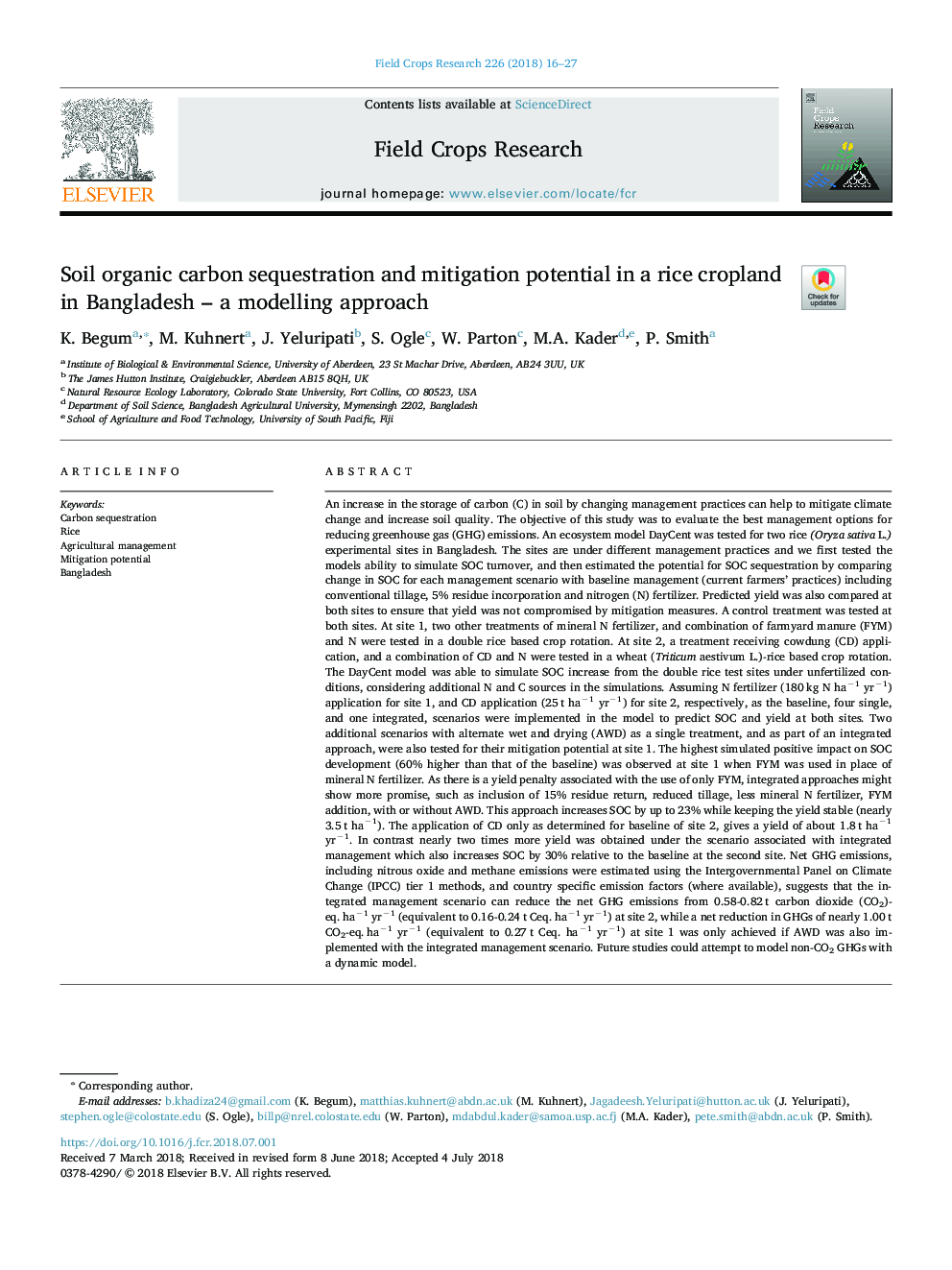| کد مقاله | کد نشریه | سال انتشار | مقاله انگلیسی | نسخه تمام متن |
|---|---|---|---|---|
| 8879066 | 1624637 | 2018 | 12 صفحه PDF | دانلود رایگان |
عنوان انگلیسی مقاله ISI
Soil organic carbon sequestration and mitigation potential in a rice cropland in Bangladesh - a modelling approach
ترجمه فارسی عنوان
پراکندگی کربن آلاینده خاک و پتانسیل کاهش آن در یک مزرعه برنج در بنگلادش - رویکرد مدل
دانلود مقاله + سفارش ترجمه
دانلود مقاله ISI انگلیسی
رایگان برای ایرانیان
کلمات کلیدی
تداخل کربن، برنج، مدیریت کشاورزی، کاهش پتانسیل، بنگلادش،
موضوعات مرتبط
علوم زیستی و بیوفناوری
علوم کشاورزی و بیولوژیک
علوم زراعت و اصلاح نباتات
چکیده انگلیسی
An increase in the storage of carbon (C) in soil by changing management practices can help to mitigate climate change and increase soil quality. The objective of this study was to evaluate the best management options for reducing greenhouse gas (GHG) emissions. An ecosystem model DayCent was tested for two rice (Oryza sativa L.) experimental sites in Bangladesh. The sites are under different management practices and we first tested the models ability to simulate SOC turnover, and then estimated the potential for SOC sequestration by comparing change in SOC for each management scenario with baseline management (current farmers' practices) including conventional tillage, 5% residue incorporation and nitrogen (N) fertilizer. Predicted yield was also compared at both sites to ensure that yield was not compromised by mitigation measures. A control treatment was tested at both sites. At site 1, two other treatments of mineral N fertilizer, and combination of farmyard manure (FYM) and N were tested in a double rice based crop rotation. At site 2, a treatment receiving cowdung (CD) application, and a combination of CD and N were tested in a wheat (Triticum aestivum L.)-rice based crop rotation. The DayCent model was able to simulate SOC increase from the double rice test sites under unfertilized conditions, considering additional N and C sources in the simulations. Assuming N fertilizer (180â¯kg N haâ1 yrâ1) application for site 1, and CD application (25â¯t haâ1 yrâ1) for site 2, respectively, as the baseline, four single, and one integrated, scenarios were implemented in the model to predict SOC and yield at both sites. Two additional scenarios with alternate wet and drying (AWD) as a single treatment, and as part of an integrated approach, were also tested for their mitigation potential at site 1. The highest simulated positive impact on SOC development (60% higher than that of the baseline) was observed at site 1 when FYM was used in place of mineral N fertilizer. As there is a yield penalty associated with the use of only FYM, integrated approaches might show more promise, such as inclusion of 15% residue return, reduced tillage, less mineral N fertilizer, FYM addition, with or without AWD. This approach increases SOC by up to 23% while keeping the yield stable (nearly 3.5â¯t haâ1). The application of CD only as determined for baseline of site 2, gives a yield of about 1.8â¯t haâ1 yrâ1. In contrast nearly two times more yield was obtained under the scenario associated with integrated management which also increases SOC by 30% relative to the baseline at the second site. Net GHG emissions, including nitrous oxide and methane emissions were estimated using the Intergovernmental Panel on Climate Change (IPCC) tier 1 methods, and country specific emission factors (where available), suggests that the integrated management scenario can reduce the net GHG emissions from 0.58-0.82â¯t carbon dioxide (CO2)-eq.â¯haâ1 yrâ1 (equivalent to 0.16-0.24â¯t Ceq. haâ1 yrâ1) at site 2, while a net reduction in GHGs of nearly 1.00â¯t CO2-eq.â¯haâ1 yrâ1 (equivalent to 0.27â¯t Ceq. haâ1 yrâ1) at site 1 was only achieved if AWD was also implemented with the integrated management scenario. Future studies could attempt to model non-CO2 GHGs with a dynamic model.
ناشر
Database: Elsevier - ScienceDirect (ساینس دایرکت)
Journal: Field Crops Research - Volume 226, 1 September 2018, Pages 16-27
Journal: Field Crops Research - Volume 226, 1 September 2018, Pages 16-27
نویسندگان
K. Begum, M. Kuhnert, J. Yeluripati, S. Ogle, W. Parton, M.A. Kader, P. Smith,
